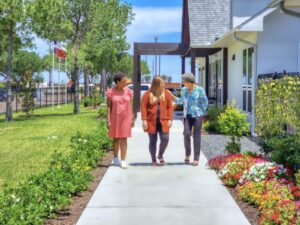
Transitioning to assisted senior living communities is a significant and often complex step in the lives of many older adults and their families. It’s a choice that involves careful consideration of various factors, emotions, and practicalities. Dive deep into the assisted living facility and senior living community process to ensure a smooth transition for you and your elderly loved one.
Understanding Assisted Living
What is assisted living?
Assisted living is a type of senior living facility designed to support and care for older adults who may need assistance with daily activities while maintaining their independence.
Assisted living community homes offer a range of benefits, including access to social events, exercise classes, a social environment, and skilled nursing care. They provide an environment that prioritizes the well-being and comfort of residents.
Making the Decision
Recognizing the need
The decision to senior living transition often begins with recognizing that the current independent living situation is no longer meeting the needs of the aging loved one. It may involve signs of declining health or difficulties in managing daily living tasks.
Involving family members
It’s essential to involve family members in the decision-making process. Discussing the assisted living community transition with siblings, elderly parents, and other close relatives can help make the process smoother and provide emotional support.
Researching assisted living facilities
Take the time to research various assisted living facilities to find the right community that suits your loved one’s needs and preferences. Consider factors like location, amenities, and the level of care services offered.
Preparing for the Transition
Packing efficiently
When the decision to move has been made, start packing efficiently. Take along familiar things like family pictures and items that provide comfort. This can help create a sense of home in the new environment.
Planning ahead
Plan ahead for the transition by creating a to-do list. This step should include notifying family members and healthcare providers, arranging transportation, and ensuring all necessary paperwork is in order.
Moving Day
Seeking support
On the moving day, it’s common to experience complex emotions. Seek support from a social worker or community staff member experienced in helping new apartment residents adjust to their new surroundings.
Meeting new residents
Encourage your loved one to engage with other residents. Assisted living communities often have welcoming committees or social events where new community residents can meet their neighbors and make new friends.
Settling in
Exploring the community
Encourage your loved one to explore their new senior living community. Many assisted living facilities offer a range of amenities, such as a dining room, gardening club, and daily living assistance.
Getting involved
Involvement in social activities and exercise classes can greatly enhance the transition period. It allows your loved one to spend time with new friends and feel more comfortable in their own home and new space.
Recognizing it’s normal
It’s important to recognize that experiencing a range of emotions during this transition is completely normal. The move from nursing home to assisted living represents a significant change, and it’s okay for both you and your loved one to have complex feelings.
Final Words
Transitioning to an assisted living facility is a significant life change for older adults and their families. By taking the time to research and plan, involving family members, and seeking support from the community staff, this transition can be a positive step toward ensuring the health and well-being of your loved one.